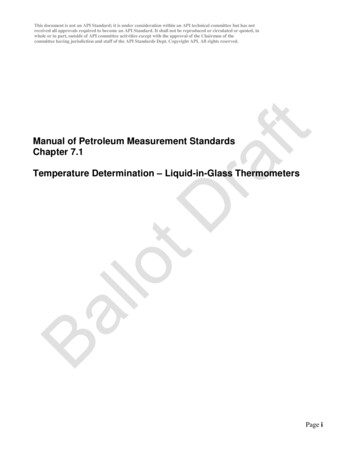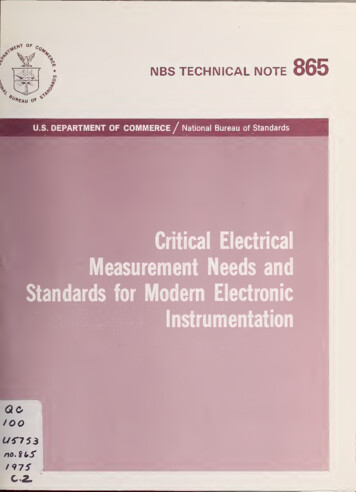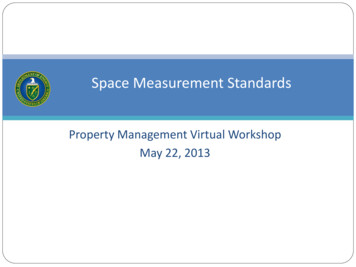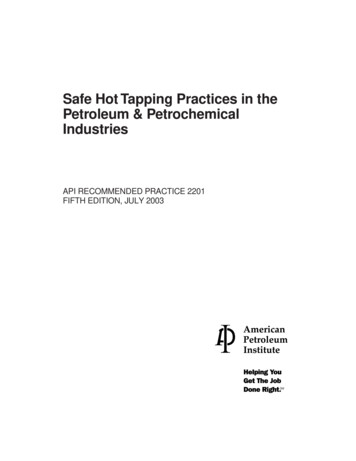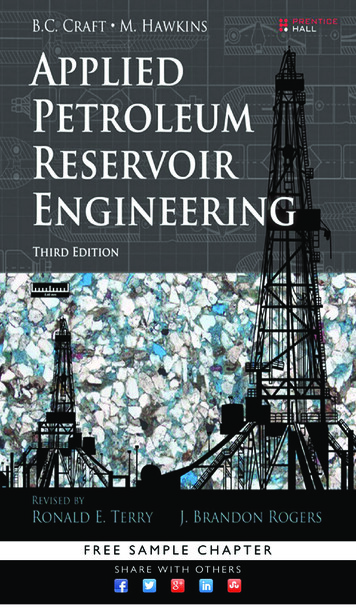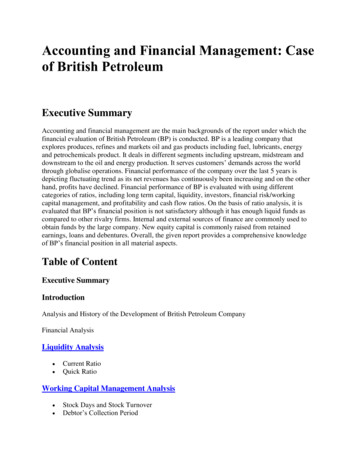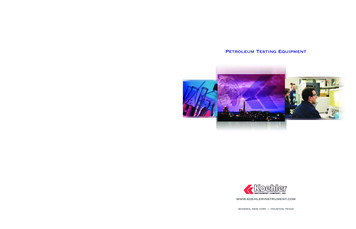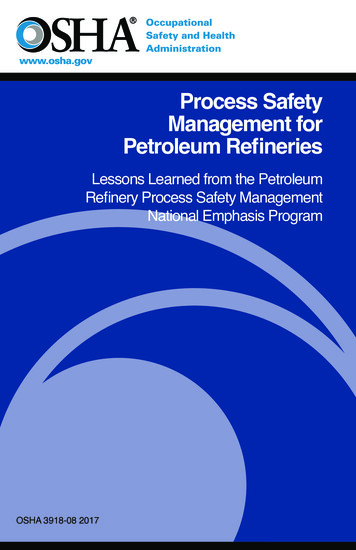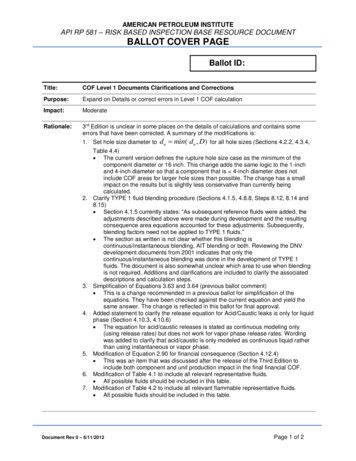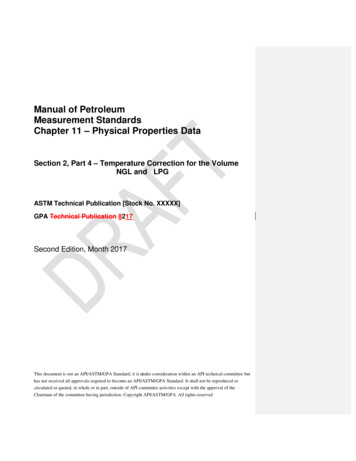
Transcription
Manual of PetroleumMeasurement StandardsChapter 11 – Physical Properties DataSection 2, Part 4 – Temperature Correction for the VolumeNGL and LPGASTM Technical Publication [Stock No. XXXXX]GPA Technical Publication 8217Second Edition, Month 2017This document is not an API/ASTM/GPA Standard; it is undericonsideration within an API technical committee buthas not received all approvals required to become an API/ASTM/GPA Standard. It shall not be reproduced orcirculated or quoted, in whole or in part, outside of API committee activities except with the approval of theChairman of the committee having jurisdiction. Copyright API/ASTM/GPA. All rights reserved
ForewordFor custody transfer purposes, natural gas liquid (NGL) and liquefied petroleum gas (LPG)volumes are generally stated at a fixed base temperature and saturation pressure. As most volumetransfers occur at temperatures and pressures other than standard conditions, these volumes areadjusted to standard conditions through the use of correction factors.This document presents a new method to calculate temperature correction factors. With thepublication of this document, previous API, ASTM and GPA documents containing NGL andLPG temperature correction factors should no longer be used. The document is specifically titledas being suitable for NGL and LPG liquids. Light hydrocarbon mixtures containing significantquantities of methane, carbon dioxide and nitrogen which have density ranges which overlapthose contained in these tables can be encountered. However, the two-fluid correlation which isthe basis of these tables was not calibrated for such mixtures.The actual Standard represented by this report consists of the explicit implementationprocedures. Sample tables and other examples created from a computerized version of theseimplementation procedures are presented within. However, these are for examples only and donot represent the Standard.Nothing contained in any API publication is to be construed as granting any right, by implicationor otherwise, for the manufacture, sale, or use of any method, apparatus, or product covered byletters patent. Neither should anything contained in the publication be construed as insuringanyone against liability for infringement of letters patent.This document was produced under API standardization procedures that ensure appropriatenotification and participation in the developmental process and is designated as an API standard.Questions concerning the interpretation of the content of this publication or comments andquestions concerning the procedures under which this publication was developed should bedirected in writing to the Director of Standards, American Petroleum Institute, 1220 L Street,N.W., Washington, D.C. 20005. Requests for permission to reproduce or translate all or any partof the material published herein should also be addressed to the director.Generally, API standards are reviewed and revised, reaffirmed, or withdrawn at least every fiveyears. A one-time extension of up to two years may be added to this review cycle. Status of thepublication can be ascertained from the API Standards Department, telephone (202) 682-8000. Acatalog of API publications and materials is published annually and updated quarterly by API,1220 L Street, N.W., Washington, D.C. 20005.Suggested revisions are invited and should be submitted to the Standards and PublicationsDepartment, API, 1220 L Street, NW, Washington, D.C. 20005, standards@api.org.This document is not an API/ASTM/GPA Standard; it is under consideration within an API technical committee buthas not received all approvals required to become an API/ASTM/GPA Standard. It shall not be reproduced orcirculated or quoted, in whole or in part, outside of API committee activities except with the approval of theChairman of the committee having jurisdiction. Copyright API/ASTM/GPA. All rights reservedii
API Special NotesAPI publications necessarily address problems of a general nature. With respect to particularcircumstances, local, state, and federal laws and regulations should be reviewed.Neither API nor any of API's employees, subcontractors, consultants, committees, or otherassignees make any warranty or representation, either express or implied, with respect to theaccuracy, completeness, or usefulness of the information contained herein, or assume anyliability or responsibility for any use, or the results of such use, of any information or processdisclosed in this publication. Neither API nor any of API's employees, subcontractors,consultants, or other assignees represent that use of this publication would not infringe uponprivately owned rights.API publications may be used by anyone desiring to do so. This publication is an updatedversion of TP-2527. Previous editions of this publication were numbered TP-25. Uponacceptance by API/GPA/ASTM, this document is no longer a technical publication but should beconsidered a standard. Hence the designation change to GPA 8217. Users of this standardshould take efforts to ensure they are using the most current version of this publication. Everyeffort has been made by the Institute to assure the accuracy and reliability of the data containedin them; however, the Institute makes no representation, warranty, or guarantee in connectionwith this publication and hereby expressly disclaims any liability or responsibility for loss ordamage resulting from its use or for the violation of any authorities having jurisdiction withwhich this publication may conflict.API publications are published to facilitate the broad availability of proven, sound engineeringand operating practices. These publications are not intended to obviate the need for applyingsound engineering judgment regarding when and where these publications should be utilized.The formulation and publication of API publications is not intended in any way to inhibit anyonefrom using any other practices.Any manufacturer marking equipment or materials in conformance with the markingrequirements of an API standard is solely responsible for complying with all the applicablerequirements of that standard. API does not represent, warrant, or guarantee that such productsdo in fact conform to the applicable API standard.This document is not an API/ASTM/GPA Standard; it is under consideration within an API technical committee buthas not received all approvals required to become an API/ASTM/GPA Standard. It shall not be reproduced orcirculated or quoted, in whole or in part, outside of API committee activities except with the approval of theChairman of the committee having jurisdiction. Copyright API/ASTM/GPA. All rights reservediii
Summary of Changes from Chapter 11.2.4, 1st edition to Chapter 11.2.4, 2nd edition.This 2nd edition revision addressed several editorial errors and issues that neededclarification. There are no changes in the 2nd edition which would change theimplementation guidelines.Table of ContentsForeword . iiAPI Special Notes . iiiThis document is not an API/ASTM/GPA Standard; it is under consideration within an API technical committee buthas not received all approvals required to become an API/ASTM/GPA Standard. It shall not be reproduced orcirculated or quoted, in whole or in part, outside of API committee activities except with the approval of theChairman of the committee having jurisdiction. Copyright API/ASTM/GPA. All rights reservediv
ASTM Note . ivGPA Disclaimer .vTable of Contents . ivNomenclature . vii1 Introduction .12 Scope .23 Significant Digits .74 Comparison to the Previous Standard .75 Implementation Procedures .125.1CTL (Table 24) and Relative Density (Table 23) for NGL and LPG using a60 F Base Temperature .125.1.1Implementation Procedure for Table 24E (60 F Basis).125.1.1.1Inputs and Outputs . 125.1.1.2Outline of Calculations . 125.1.1.3T24 Implementation Procedure. 135.1.1.4Examples for Section 5.1.1 (Table 24E) . 195.1.2Implementation Procedure for Table 23E (60 F Basis). 505.1.2.1Inputs and Outputs . 505.1.2.2Outline of Calculations . 505.1.2.3T23 Implementation Procedure. 515.1.2.4Examples for Section 5.1.2 (Table 23E) . 605.2CTL (Table 54) and Density (Table 53) for NGL and LPG using a 15 C BaseTemperature .905.2.1Implementation Procedure for Table 54E (15 C Basis) . 905.2.1.1Inputs and Outputs . 905.2.1.2Outline of Calculations . 905.2.1.3T54 Implementation Procedure. 905.2.1.4Examples for Section 5.2.2 (Table 54E) . 945.2.2Implementation Procedure for Table 53E (15 C Basis) . 1125.2.2.1Inputs and Outputs . 1125.2.2.2Outline of Calculations . 1125.2.2.3T53 Implementation Procedure. 1125.2.2.4Examples for Section 5.2.2 (Table 53E) . 85This document is not an API/ASTM/GPA Standard; it is under consideration within an API technical committee buthas not received all approvals required to become an API/ASTM/GPA Standard. It shall not be reproduced orcirculated or quoted, in whole or in part, outside of API committee activities except with the approval of theChairman of the committee having jurisdiction. Copyright API/ASTM/GPA. All rights reservedv
5.3CTL (Table 60) and Density (Table 59) for NGL and LPG using a 20 C BaseTemperature . 1315.3.1Implementation Procedure for Table 60E (20 C Basis) . 1315.3.1.1Inputs and Outputs . 1315.3.1.2Outline of Calculations . 1315.3.1.3T60 Implementation Procedure. 1315.3.1.4Examples for Section 5.3.1 (Table 60) . 1355.3.2Implementation Procedure for Table 59E (20 C Basis) . 1535.3.2.1Inputs and Outputs . 1535.3.2.2Outline of Calculations . 1535.3.2.3T59 Implementation Procedure. 1535.3.2.4Examples for Section 5.3.2 (Table 59E) . 1576Sample Sections of Printed Tables .1737References .185This document is not an API/ASTM/GPA Standard; it is under consideration within an API technical committee buthas not received all approvals required to become an API/ASTM/GPA Standard. It shall not be reproduced orcirculated or quoted, in whole or in part, outside of API committee activities except with the approval of theChairman of the committee having jurisdiction. Copyright API/ASTM/GPA. All rights reservedvi
NomenclatureA, B, CCTLh2k1, k2, k3, k4TBTBKTcTc,refTFTr,xTxV60/VTxXZc x x x,high x,low x,mid x,trial 60 Tx 60,
acceptance by API/GPA/ASTM, this document is no longer a technical publication but should be considered a standard. Hence the designation change to GPA 8217. Users of this standard should take efforts to ensure they are using the most current version of this publication. Every effort has been made by the Institute to assure the accuracy and reliability of the data contained in them; however .
